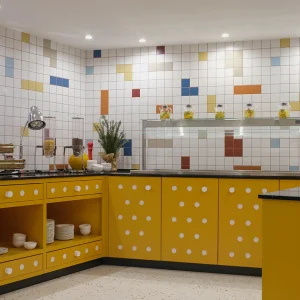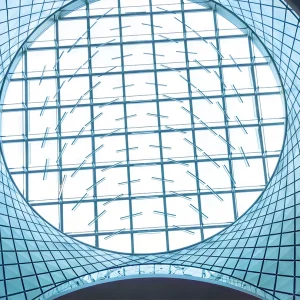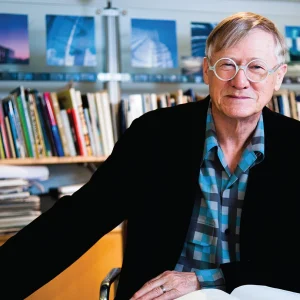
The Chicago weather for Neocon in June was decidedly unseasonal: delegates were welcomed on the first day by overcast skies and cool temperatures, followed two days later by threats of a ‘derecho’ – destructive winds, golf ball-sized hail, flash flooding and tornadoes. In between, the weather gave us a taste of everything, including fog.
In contrast, the business atmosphere was anything but cool – it was like old times, with lots of optimism and enthusiasm. There may not have been quite as many dramatic new products as in the past, but after years of economic upheaval and the dumbing-down effects of aggressively priced commodity products from Asia, there was evidence of fresh thinking and design-led investment from some of the larger companies.
More than 45,000 had pre-registered for the show, many more than in recent years and, judging by the massive Monday morning crowds fighting their way through the registration process, they all arrived at the same time. In theory, Neocon is a three-day show, and if only visits were spread more evenly across the opening hours the visitor experience would be much more satisfactory. Instead, everyone turns up on Monday, overloads the elevators, blocks the corridors and swamps the showrooms, especially on the third floor.
No one expects to get salespeople’s attention on the Monday, so new ideas and products go unexplained. The trickle of visitors on the Wednesday have the luxury of viewings in peace and quiet, but no hope of seeing anyone senior – they have all gone home, exhausted.
Neocon has largely become two shows; the permanent showrooms on floors 3, 10 and 11 have little to do with the temporary show stands on floors 7 and 8. Us and them. Who is ‘us’ and who is ‘them’ depends on your perspective. The space available on floors 7, and to an even greater extent on 8, was not fully taken up, which was probably a reflection of the state of the markets in the countries from where these exhibitors usually hail. Similarly, there seemed to be fewer overseas visitors than in past years. By contrast, everything about the permanent showroom floors was hyper – not a spare inch of space, and the heave of visitors made it hard to get around.
The most obvious trends involved aspects of technology, European styling, homely furniture, earthy colours and felt. It’s been three years since Steelcase launched Mediascape, and the scale of collaboration it was intended to foster has gone from a few people gathered around a screen to transcontinental. Some companies appeared to be so intent on promoting the technology they seemed to have forgotten they’re furniture manufacturers.
Although there was no evidence of any wholesale invasion by European companies into the market, European styles of benches and high-backed seating enclosures abounded; Teknion had gone one step further, with its prominently displayed new alliance with B&B Italia. As for colours, white benches were fighting upholstered furniture in primary colours and shades of yellow and orange. But there was also a noticeable use of earthy, muted, browns, tans, warm greys and greens. Felt as an upholstery material made its appearance in 2012 but this year it was everywhere – suspended from ceilings, sitting on floors and dividing up spaces.
For some years, the trade association, BIFMA, has heavily promoted its environmental and sustainability standard it calls Level, which has been taken up by 50 companies, including some from outside North America. This led this year to signed-up companies, and others, promoting all things environmental. One wonders whether all the claims they made were really sustainable.
The outstanding ‘major’ this year was undoubtedly Herman Miller. Its showroom had been recreated to present the Living Office, the company’s answer to its research into the ways people sit, stand, communicate, gather and perform activities in a work environment. The furniture was attractive and elegant: Locale from Sam Hecht and Kim Colin created attractive open-plan working areas, and Metaform, designed by Studio 7.5, used lightweight modular blocks to allow easily reconfigurable areas for almost any purpose.
Davis is one of the smaller companies with a permanent showroom in the Mart, but has a larger-than-life image. This design-inspired firm achieves high-quality manufacturing to match the quality of its designs, which come from some of Europe’s finest. This year it showed an elegant, very long, walnut veneered table called Span, supported only by four slim, veneered steel-tube corner legs. Its Stix coat racks also attracted attention.
Steelcase had further developed its Mediascape collaborative table and screen so that users were optionally connected wirelessly, but its real star was the clever Gesture chair, designed by Glen Oliver in conjunction with its in-house team. The design was driven by the different ways people sit to use tablets and smartphones. The chair is ‘one size fits all’ with arms that can be contorted in all directions. Claudio Bellini inspired the in-house team in the creation of the new VIA wall system, which has good acoustic properties and a wide range of options.
The Steelcase company Coalesse, which is often a source of innovative product ideas, showed a design from Jean-Marie Massaud – the Massaud Work Lounge, with a canopy that can be lowered to enclose the occupant.
More usually known for its classic, design-led furniture with strong aesthetic appeal rather than for clever engineering, Knoll this year launched Tools for Life, by Rem Koolhass. It uses three connected square cylinders in two sizes that pivot to create units of reception and lounge furniture.
Haworth focused on collaboration, using technology and soft furniture, and presented Bluescape – a collaboration with Obscura Digital. This software allowed massive screens to run tablet-type activities for participants anywhere in the world to all join in at the same time, while the Collaborative Lounge range of ultra-lightweight screens looked very practical.
HNI Corp companies together occupy several large showrooms in the Mart, each under one of their brands that include HON, Allsteel, Gunlocke, Paoli and HBF. The group’s companies and products serve the broad middle-market sectors and they have been known to describe themselves as ‘fast followers’ rather than innovators. This year, unusually, HON introduced a truly ground-breaking product – the attractive and cleverly engineered Purpose chair, from the charismatic Marcus Koepke. It uses passive technology rather than knobs, buttons and levers to create a very comfortable sieat. The group has considerable resources, and if this launch is an indication of further investment in creative new products it will make the market sit up and take notice.
Away from the permanent showroom floors, China’s Saosen showed brightly coloured workstations made from epoxy powder-coated MDF, while the UK’s Kwick Screen attracted plenty of interest with its large, flexible, pullout screen that can quickly divide spaces and form temporary rooms, and David Winston from Los Angeles showed his simple and elegant Eyhov workstation system for Scale 1:1.
The acoustic and environmentally friendly properties of felt were promoted. Knoll showed the colourful Fitzfelt hangings and floor mats by Ayshe Birsel, and the new BuzziSpace showroom left you wondering just what couldn’t be made from felt. And Humanscale, whose iconic designer Niels Diffrient had died just before the show opened, launched his new Smart chair that took the already understated Liberty chair to a new level of simplicity.
Design-led group, OFS Brands, showed further developments of its 11 Work Space range and The Edge by First Office – a mixed-use collection for the office, while Vitra’s showroom featured a variety of enclosures, including Workbays by Ronan & Erwan Bouroullec. Okamura from Tokyo showed its new Choral task chair whose deceptively simple appearance concealed innovative technology, including ankle tilt/recline and seat-pivot suspension.
KI’s enclosures – and most showrooms had variations on the same theme – were for individual use rather than group activity. Apart from the new link-up with B&B Italia, which grabbed a large part of the Teknion showroom, the company also announced the launch of a new textiles division that attracted much interest, and showed its new Interpret range of benches and workstations and the Fractals seating group of soft seating, which won a Neocon Gold Award.
There wasn’t as much lighthearted fun this year. Apart from lots of noisy bucolic showroom parties – why were they all held at the same time on Monday afternoon? – there was only AIS’s silent disco; a bit like the visual equivalent of a karaoke it bemused most visitors, who looked as though they were rather too self-conscious to join in.





